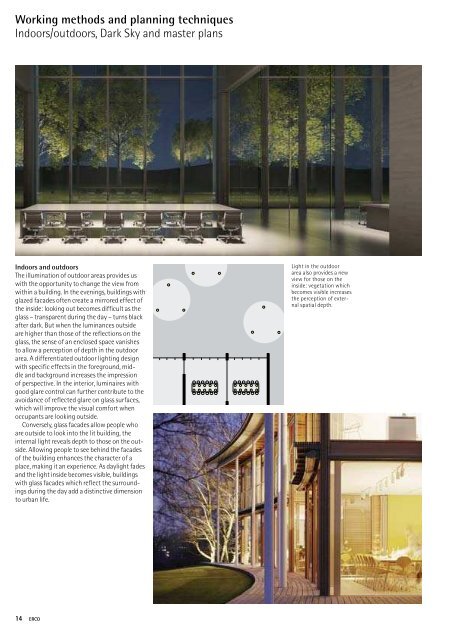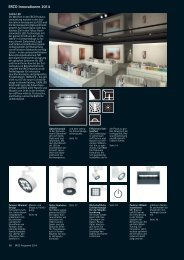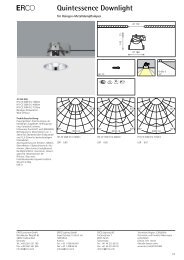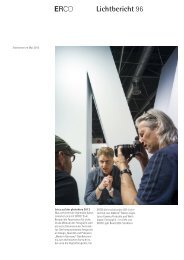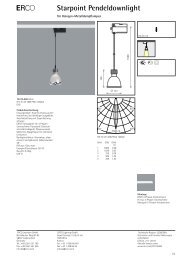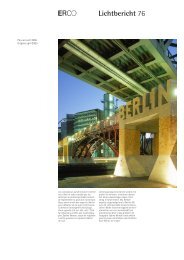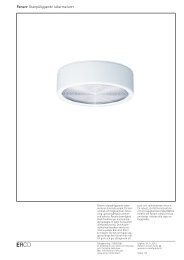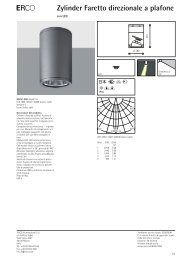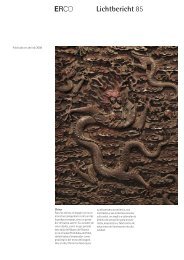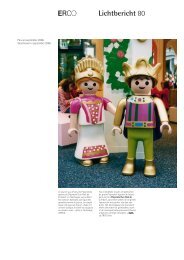Light in the outdoor area - Erco
Light in the outdoor area - Erco
Light in the outdoor area - Erco
Create successful ePaper yourself
Turn your PDF publications into a flip-book with our unique Google optimized e-Paper software.
Work<strong>in</strong>g methods and plann<strong>in</strong>g techniques<br />
Indoors/<strong>outdoor</strong>s, Dark Sky and master plans<br />
Indoors and <strong>outdoor</strong>s<br />
The illum<strong>in</strong>ation of <strong>outdoor</strong> <strong>area</strong>s provides us<br />
with <strong>the</strong> opportunity to change <strong>the</strong> view from<br />
with<strong>in</strong> a build<strong>in</strong>g. In <strong>the</strong> even<strong>in</strong>gs, build<strong>in</strong>gs with<br />
glazed facades often create a mirrored effect of<br />
<strong>the</strong> <strong>in</strong>side: look<strong>in</strong>g out becomes difficult as <strong>the</strong><br />
glass – transparent dur<strong>in</strong>g <strong>the</strong> day – turns black<br />
after dark. But when <strong>the</strong> lum<strong>in</strong>ances outside<br />
are higher than those of <strong>the</strong> reflections on <strong>the</strong><br />
glass, <strong>the</strong> sense of an enclosed space vanishes<br />
to allow a perception of depth <strong>in</strong> <strong>the</strong> <strong>outdoor</strong><br />
<strong>area</strong>. A differentiated <strong>outdoor</strong> light<strong>in</strong>g design<br />
with specific effects <strong>in</strong> <strong>the</strong> foreground, middle<br />
and background <strong>in</strong>creases <strong>the</strong> impression<br />
of perspective. In <strong>the</strong> <strong>in</strong>terior, lum<strong>in</strong>aires with<br />
good glare control can fur<strong>the</strong>r contribute to <strong>the</strong><br />
avoidance of reflected glare on glass surfaces,<br />
which will improve <strong>the</strong> visual comfort when<br />
occupants are look<strong>in</strong>g outside.<br />
Conversely, glass facades allow people who<br />
are outside to look <strong>in</strong>to <strong>the</strong> lit build<strong>in</strong>g, <strong>the</strong><br />
<strong>in</strong>ternal light reveals depth to those on <strong>the</strong> outside.<br />
Allow<strong>in</strong>g people to see beh<strong>in</strong>d <strong>the</strong> facades<br />
of <strong>the</strong> build<strong>in</strong>g enhances <strong>the</strong> character of a<br />
place, mak<strong>in</strong>g it an experience. As daylight fades<br />
and <strong>the</strong> light <strong>in</strong>side becomes visible, build<strong>in</strong>gs<br />
with glass facades which reflect <strong>the</strong> surround<strong>in</strong>gs<br />
dur<strong>in</strong>g <strong>the</strong> day add a dist<strong>in</strong>ctive dimension<br />
to urban life.<br />
<strong>Light</strong> <strong>in</strong> <strong>the</strong> <strong>outdoor</strong><br />
<strong>area</strong> also provides a new<br />
view for those on <strong>the</strong><br />
<strong>in</strong>side: vegetation which<br />
becomes visible <strong>in</strong>creases<br />
<strong>the</strong> perception of external<br />
spatial depth.<br />
Dark Sky<br />
In <strong>the</strong> past, <strong>the</strong> desire to enhance as many<br />
places and spaces as possible us<strong>in</strong>g artificial<br />
light has on occasions taken precedence over<br />
environmental concerns. At times, <strong>the</strong> night<br />
has become almost as bright as day, and <strong>the</strong><br />
thoughtless use especially of lum<strong>in</strong>aires with<br />
<strong>in</strong>discrim<strong>in</strong>ate light distribution has added to<br />
<strong>the</strong> problem of light pollution. <strong>Light</strong> pollution<br />
refers to <strong>the</strong> spill light that causes a disturbance<br />
<strong>in</strong> a given context due to its illum<strong>in</strong>ance, beam<br />
direction or light spectrum. Spill light and glare<br />
impair visual comfort; <strong>in</strong>formation content that<br />
was to be conveyed fails to have <strong>the</strong> desired<br />
effect. The ecological consequences <strong>in</strong>clude a<br />
waste of energy and negative impact on both<br />
flora and fauna. Dark Sky requires that light<strong>in</strong>g<br />
design for <strong>outdoor</strong> <strong>area</strong>s is restricted to only<br />
that which is essential. If this is applied, <strong>the</strong>n<br />
light pollution is avoided and for astronomers,<br />
observation of <strong>the</strong> night sky is enhanced. This<br />
approach requires an effective design concept<br />
with a lum<strong>in</strong>aire technology tailored to suit.<br />
Cooperation between light<strong>in</strong>g designers, architects,<br />
landscape architects, build<strong>in</strong>g owners,<br />
electrical <strong>in</strong>stallers and lum<strong>in</strong>aire manufacturers<br />
is required for <strong>the</strong> successful implementation<br />
of a Dark Sky concept.<br />
Master plans<br />
Similar to urban development master plans,<br />
<strong>the</strong> same is required <strong>in</strong> <strong>the</strong> context of light<strong>in</strong>g<br />
design to document its pr<strong>in</strong>ciples for <strong>the</strong><br />
after-dark appearance of urban development,<br />
city centres and even entire regions. One of <strong>the</strong><br />
objectives of such plann<strong>in</strong>g is to establish <strong>the</strong><br />
identity of a place and to def<strong>in</strong>e a concept that<br />
makes for an attractive appearance at night.<br />
The fundamental elements of a light<strong>in</strong>g master<br />
plan <strong>in</strong>clude enhanced orientation by focus<strong>in</strong>g<br />
on city entrances, landmarks and traffic routes,<br />
a concept that ensures <strong>the</strong> visibility of <strong>the</strong> city<br />
from a distance by detail<strong>in</strong>g <strong>the</strong> specifications<br />
for <strong>the</strong> silhouette, and guid<strong>in</strong>g pr<strong>in</strong>ciples for<br />
<strong>the</strong> light<strong>in</strong>g design of sites. The master plan is<br />
<strong>the</strong>n used to identify <strong>the</strong> objectives of <strong>the</strong> specific<br />
project <strong>in</strong> relationship to <strong>the</strong> environment.<br />
In addition to qualitative aspects, a light<strong>in</strong>g<br />
master plan might also provide guidel<strong>in</strong>es for<br />
economic efficiency, environmental protection<br />
and road safety.<br />
<strong>Light</strong><strong>in</strong>g master plans<br />
can be used to identify<br />
pr<strong>in</strong>ciples for <strong>the</strong> light<strong>in</strong>g<br />
design of a specific<br />
build<strong>in</strong>g to ensure that<br />
consistent parameters<br />
are applied to urban<br />
development.<br />
Spill light can be prevented<br />
by us<strong>in</strong>g precise<br />
light<strong>in</strong>g technology<br />
and <strong>the</strong> correct arrangement<br />
of lum<strong>in</strong>aires to<br />
ensure optimal visual<br />
comfort for passers-by<br />
and drivers.<br />
14 ERCO ERCO 15


